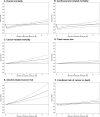The association of lifetime alcohol use with mortality and cancer risk in older adults: A cohort study
- PMID: 29920516
- PMCID: PMC6007830
- DOI: 10.1371/journal.pmed.1002585
The association of lifetime alcohol use with mortality and cancer risk in older adults: A cohort study
Abstract
Background: While current research is largely consistent as to the harms of heavy drinking in terms of both cancer incidence and mortality, there are disparate messages regarding the safety of light-moderate alcohol consumption, which may confuse public health messages. We aimed to evaluate the association between average lifetime alcohol intakes and risk of both cancer incidence and mortality.
Methods and findings: We report a population-based cohort study using data from 99,654 adults (68.7% female), aged 55-74 years, participating in the U.S. Prostate, Lung, Colorectal, and Ovarian (PLCO) Cancer Screening Trial. Cox proportional hazards models assessed the risk of overall and cause-specific mortality, cancer incidence (excluding nonmelanoma skin cancer), and combined risk of cancer and death across categories of self-reported average lifetime alcohol intakes, with adjustment for potential confounders. During 836,740 person-years of follow-up (median 8.9 years), 9,599 deaths and 12,763 primary cancers occurred. Positive linear associations were observed between lifetime alcohol consumption and cancer-related mortality and total cancer incidence. J-shaped associations were observed between average lifetime alcohol consumption and overall mortality, cardiovascular-related mortality, and combined risk of death or cancer. In comparison to lifetime light alcohol drinkers (1-3 drinks per week), lifetime never or infrequent drinkers (<1 drink/week), as well as heavy (2-<3 drinks/day) and very heavy drinkers (3+ drinks/day) had increased overall mortality and combined risk of cancer or death. Corresponding hazard ratios (HRs) and 95% confidence intervals (CIs) for combined risk of cancer or death, respectively, were 1.09 (1.01-1.13) for never drinkers, 1.08 (1.03-1.13) for infrequent drinkers, 1.10 (1.02-1.18) for heavy drinkers, and 1.21 (1.13-1.30) for very heavy drinkers. This analysis is limited to older adults, and residual confounding by socioeconomic factors is possible.
Conclusions: The study supports a J-shaped association between alcohol and mortality in older adults, which remains after adjustment for cancer risk. The results indicate that intakes below 1 drink per day were associated with the lowest risk of death.
Trial registration: NCT00339495 (ClinicalTrials.gov).
Conflict of interest statement
The authors have declared that no competing interests exist.
Figures





Similar articles
-
Relationship of Alcohol Consumption to All-Cause, Cardiovascular, and Cancer-Related Mortality in U.S. Adults.J Am Coll Cardiol. 2017 Aug 22;70(8):913-922. doi: 10.1016/j.jacc.2017.06.054. J Am Coll Cardiol. 2017. PMID: 28818200
-
Low-level alcohol consumption and cancer mortality.Sci Rep. 2021 Feb 25;11(1):4585. doi: 10.1038/s41598-021-84181-1. Sci Rep. 2021. PMID: 33633295 Free PMC article.
-
Alcohol consumption and mortality risks in the USA.Alcohol Alcohol. 2012 May-Jun;47(3):334-9. doi: 10.1093/alcalc/agr171. Epub 2012 Jan 25. Alcohol Alcohol. 2012. PMID: 22278318
-
The level of alcohol consumption at which all-cause mortality is least.J Clin Epidemiol. 1999 Oct;52(10):967-75. doi: 10.1016/s0895-4356(99)00076-1. J Clin Epidemiol. 1999. PMID: 10513760
-
Why Do Only Some Cohort Studies Find Health Benefits From Low-Volume Alcohol Use? A Systematic Review and Meta-Analysis of Study Characteristics That May Bias Mortality Risk Estimates.J Stud Alcohol Drugs. 2024 Jul;85(4):441-452. doi: 10.15288/jsad.23-00283. Epub 2024 Jan 30. J Stud Alcohol Drugs. 2024. PMID: 38289182
Cited by
-
Association of educational attainment with cancer mortality in a national cohort study of black and white adults: A mediation analysis.SSM Popul Health. 2023 Oct 26;24:101546. doi: 10.1016/j.ssmph.2023.101546. eCollection 2023 Dec. SSM Popul Health. 2023. PMID: 37954012 Free PMC article.
-
Sustained Hypothetical Interventions on Midlife Alcohol Consumption in Relation to All-Cause and Cancer Mortality: The Australian Longitudinal Study on Women's Health.Am J Epidemiol. 2024 Jan 8;193(1):75-86. doi: 10.1093/aje/kwad164. Am J Epidemiol. 2024. PMID: 37489623 Free PMC article.
-
Constructions of alcohol consumption by non-problematised middle-aged drinkers: a qualitative systematic review.BMC Public Health. 2018 Sep 18;18(1):1016. doi: 10.1186/s12889-018-5948-x. BMC Public Health. 2018. PMID: 30223805 Free PMC article.
-
Impact of Behavioral Risk Factors on Mortality Risk in Older Korean Women.Iran J Public Health. 2022 Jan;51(1):105-114. doi: 10.18502/ijph.v51i1.8301. Iran J Public Health. 2022. PMID: 35223631 Free PMC article.
-
The effects of modest drinking on life expectancy and mortality risks: a population-based cohort study.Sci Rep. 2022 May 6;12(1):7476. doi: 10.1038/s41598-022-11427-x. Sci Rep. 2022. PMID: 35523974 Free PMC article.
References
-
- Chikritzhs T, Stockwell T, Naimi T, Andreasson S, Dangardt F, Liang W. Has the leaning tower of presumed health benefits from “moderate” alcohol use finally collapsed? Addiction. 2015;110(5): 726–727. doi: 10.1111/add.12828 - DOI - PubMed
-
- Bell S, Daskalopoulou M, Rapsomaniki E, George J, Britton A, Bobak M, et al. Association between clinically recorded alcohol consumption and initial presentation of 12 cardiovascular diseases: population based cohort study using linked health records. BMJ. 2017;356: j909 doi: 10.1136/bmj.j909 - DOI - PMC - PubMed
-
- Topiwala A, Allan CL, Valkanova V, Zsoldos E, Filippini N, Sexton C, et al. Moderate alcohol consumption as risk factor for adverse brain outcomes and cognitive decline: longitudinal cohort study. BMJ. 2017;357: j2353 doi: 10.1136/bmj.j2353 - DOI - PMC - PubMed
-
- Ferrari P, Licaj I, Muller DC, Kragh Andersen P, Johansson M, Boeing H, et al. Lifetime alcohol use and overall and cause-specific mortality in the European Prospective Investigation into Cancer and nutrition (EPIC) study. BMJ Open. 2014;4(7): e005245 doi: 10.1136/bmjopen-2014-005245 - DOI - PMC - PubMed
Publication types
MeSH terms
Associated data
LinkOut - more resources
Full Text Sources
Other Literature Sources
Medical

